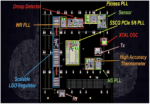- Investors finally realize the upcycle isn’t as strong as stocks indicated
- Industry Bifurcation between AI & rest of industry continues
- China spending risk/overhang finally kicks in
- AI is super strong, majority of chips remain weak- Invest accordingly
ASML simply states chip industry reality that investors have long ignored
Chip stocks and most specifically ASML got crushed yesterday when ASML mistakenly pre-announced their quarter a day early.
Quarter results were fine and in line as expected but orders, at $2.6B, were absolutely horrible, coming in at less than half of expectation.
As a result, ASMLs expectations for 2025 will come down. Q4 is in good shape and will include 2 High NA systems (Intel), but the longer term, 2025 and beyond, remains the issue.
Basically, ASML pointed to a more gradual recovery of the semiconductor industry, while AI remains very strong, the rest (majority) of the industry remains weak and has gotten weaker in recent months (Intel & Samsung).
This should certainly NOT be a surprise as we have been talking extensively, for a year, about a slower recovery than past recoveries as both trailing edge, non AI and memory (non HBM) have been weak and its difficult, if not impossible to have a full recovery based on the strength of a small part of the overall chip market, AI.
We told you so….and so did the chip companies themselves
Aside from the fact that we have been warning about overdone chip stocks for quite some time, if we go back to the equipment companies earnings reports themselves we have not seen a huge uptick in numbers nor a pronouncement by managements that the industry is off to the races again.
Instead we have heard only slow improvements and modest investments (with the exception of China).
If you look at the revenues of equipment companies like AMAT, KLAC and LRCX you will note that there has not been a sharp uptick in revenues as in cycles past even though the stock valuations have seen a sharp uptick reflective of a stronger upturn than has actually been happening….so the disconnect between reality and the stocks has widened…..
Mistakenly taking AI as an indicator of the broader, entire chip market
The mistake that many investors and inexperienced analysts have made is to take the huge, rip roaring success of AI and translate it as indicator of the entirety of the chip market….Wrong! We have reminded investors many times that HBM memory is a single digit percentage of the overall memory market and Nvidia AI chips are at the very bleeding edge of overall chip capacity neither one nor both taken together are an indicator of chip market health.
Yet many investors and analysts have mistakenly gotten caught up in the wave of AI excitement and have dragged the valuation of the entire sector up along with it.
Bifurcation of chip industry into haves (AI) and have nots (everything else)
We have spoken extensively about the bifurcation of the chip industry into AI and everything else. This bifurcation will clearly continue as Nvidia is sold out for a year while regular memory, trailing edge logic and most of the rest of the chip industry remains weak.
The fact is that AI will remain on fire while the rest of the industry languishes….investors and analysts have a hard time wrapping their heads around that dichotomy.
It is also equally import to distinguish between AI stocks and the rest of the industry as we saw Nvidias shares get sold off , in the selling frenzy, along with other chip stocks even though they remain the stand out.
China head fake/risk finally coming in to play
ASML mentioned on their call that China sales will return to a more “normalized” rate. Obviously China has been spending as fast as possible to avoid possible sanctions and clearly spending more than rationally makes sense.
Anyone who thought China would continue to spend at the current pace is naive or doesn’t understand the market.
The spend can’t go on forever and even if China wanted to continue to try to buy up all the scanners they could eventually the US will finally get sanctions in place.
In essence, the head fake is that many investors/analysts mistakenly thought that Chinese spend was real and would continue as is and did not discount for an eventual slowing.
Rest of chip equipment will follow ASML
ASML remains the monopolistic engine that drives the train of semiconductor equipment stocks. They typically see things first as scanners have a long lead time and need to be ordered long before dep and etch which is more of a turns business. If China slows ordering litho scanners, they certainly don’t need dep (AMAT), etch (LRCX) and yield management (KLAC).
So the sell off in the chip equipment industry overall seems justified.
Obviously Samsung & Intel should have been a stronger warning to investors in the group but most chose to ignore those key warnings.
The Stocks
We have said that the stocks were overvalued for a while. We have repeatedly said that AI was essentially the sole and only driver and the rest of the industry was at best, weak.
The stocks have been trading at the high end of the overall PE range seemingly unbothered by reality and egged on by the AI tidal wave.
We think the reset we saw yesterday should make investors much more selective and not just buy any chip stock that has a less than ridiculous valuation.
We maintain our positive view on Nvidia and feel that it has essentially zero to do with yesterdays sell off as it is in a much different universe.
TSMC is doing very well as Nvidias essentially sole supplier but slightyly more tempered as its trailing edge capacity is weaker. However we would point out that the vast majority of TSMC’s profitability comes from leading edge such as Nvidia and Apple and trailing edge does not much more than squeezing out additional revenue from already depreciated fabs.
ASML is still a great, monopolistic , bleeding edge company, which leads all other semiconductor equipment companies in import. Clearly the shine has come off as expectations are reduced and the China risk is more apparent than before. The valuation was overheated and will now more accurately reflect the reality of the industry.
Going forward we think that investors have to me much more selective between the have and have nots. Continue to focus on AI (Nvidia) and HBM but Do Not assume it drives the entire chip market. Look for those who benefit more directly from AI and related trends.
We would remind investors that we remain fearful of the eventual chip capacity coming on line from China from all the huge numbers of tools they have been buying. When this capacity eventually comes on line it could crush what is an already weak trailing edge chip foundry market. So far that has not yet happened, but its a matter of time.
We hope that the large dose of reality yesterday, resets investors discipline in investing in the sector.
“Reality, What a concept!”
Robin Williams (RIP)
About Semiconductor Advisors LLC
Semiconductor Advisors is an RIA (a Registered Investment Advisor),
specializing in technology companies with particular emphasis on semiconductor and semiconductor equipment companies.
We have been covering the space longer and been involved with more transactions than any other financial professional in the space.
We provide research, consulting and advisory services on strategic and financial matters to both industry participants as well as investors.
We offer expert, intelligent, balanced research and advice. Our opinions are very direct and honest and offer an unbiased view as compared to other sources.
Also Read:
SPIE Monterey- ASML, INTC – High NA Readiness- Bigger Masks/Smaller Features
Samsung Adds to Bad Semiconductor News
AMAT Underwhelms- China & GM & ICAP Headwinds- AI is only Driver- Slow Recovery









